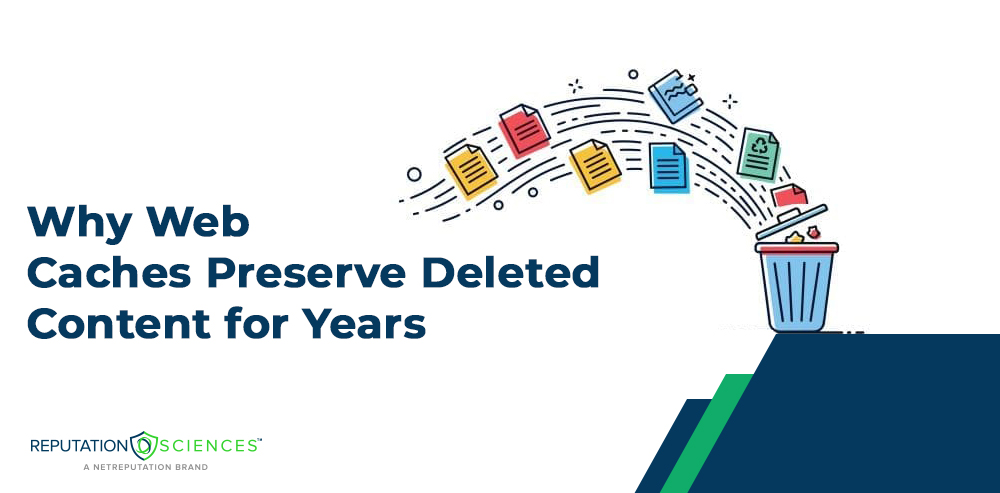Why Web Caches Preserve Deleted Content for Years

You may think deleting a post, article, or photo removes it from the internet. But for search engines, browser caches, and proxy caches, “delete” doesn’t always mean gone. Cached content—snapshots stored for speed and efficiency—can stick around for months or even years. That can be a problem, especially if what you deleted damages your reputation.
What Is a Web Cache—and Why Does It Matter?
A web cache stores copies of web content, such as HTML pages, CSS stylesheets, and JavaScript files, to improve page speed and reduce server load. When you visit a website, your browser saves a cached version of the page—called a browser cache—so it loads faster next time. Meanwhile, proxy caches and content delivery networks (CDNs) store cached resources closer to your location, reducing network traffic and improving performance.
This system boosts efficiency but can compromise privacy. If a page gets deleted or updated, the cached version might still exist on:
- Your own browser
- Intermediate caches like reverse proxies
- Search engine caches
- Third-party tools archiving snapshots of web pages
In reputation management, that delay between deletion and disappearance can cause real harm—especially when cached versions contain sensitive, false, or damaging information.
How Web Caches Keep Deleted Content Alive
Browser caching, object caching, and server-side caching all work similarly: they store web content once and serve it multiple times.
Here’s where it gets tricky: each cached item includes HTTP headers, such as Cache-Control, Expires, or ETag, that instruct the web server, browser, or proxy cache on how long to retain it. If that “expiration date” is far in the future—or missing—cached content might remain long after you deleted it from the original site.
Other mechanisms, such as cache-control headers, conditional requests, and last-modified headers, also influence how long web content remains available in shared caches, private caches, and cache storage.
These delays are usually intentional—to reduce server checks and improve website performance. However, for individuals trying to erase an outdated mugshot, a false article, or old legal records, the persistence of cached responses can exacerbate an already difficult situation.
Why Deleted Content Is a Reputation Risk
Individuals facing online defamation, mugshot removal, or outdated legal accusations may discover that deleted content continues to haunt them through web caching. Even after removing content from the origin server or convincing a publisher to unpublish something, cached content may still:
- Appear in Google search results for weeks or months
- Be accessible via direct link from shared caches
- Show outdated headlines, file names, or HTML documents
- Persist in cached representations stored by intermediate caches
This lag can lead to misinformation, reputational harm, and unwanted exposure. And because different web servers and proxy caches operate independently, no one can guarantee when deleted content will stop appearing across platforms.
Why Web Caches Are Designed This Way
Web caching aims to improve performance. When a user requests a web page, caching allows that same request to return a cached resource quickly instead of sending a new HTTP request to the origin server. This reduces server strain, saves bandwidth, and improves the user experience.
But this system can backfire when:
- Cache control max-age is too long
- No cache control headers are used at all
- Content served from an old proxy cache
- Cached files appear in search engines or archive sites
Because every cached response captures a moment in time, users may see outdated or even harmful information that no longer reflects reality—especially on high-traffic or slow-to-update platforms.
Can Deleted Content Be Fully Removed?
It depends.
If your browser or server cache stores content, clearing it may be straightforward. But proxy caches, reverse proxies, or content delivery networks can hold cached versions that prove harder to purge. Search engines that index and store the content might require a formal removal request.
Some content stays for legitimate reasons (e.g., legal records, transparency archives). Other content lingers due to poorly managed cache control settings or aggressive performance optimizations.
What You Can Do About It
If you deleted something harmful—or had it removed by a publisher—but it still appears online, try these steps:
1. Clear Local Browser Caches
Use browser settings to delete stored data, especially on modern web servers that frequently update cached assets, such as JavaScript files or CSS stylesheets.
2. Use Search Engine Removal Tools
Google and Bing offer URL removal tools for outdated content, particularly when a page is no longer accessible but a cached representation remains.
3. Contact Site Owners or Hosting Providers
Request they purge caches, update the .htaccess files, or configuration files to prevent long-term storage.
4. Work With a Reputation Management Firm
Professionals understand how cache data is transferred between private and shared caches and can help suppress outdated content in search results.
5. Set Proper Headers on Your Own Content
If you manage a website, use Cache-Control: no-cache or set short max-age values to prevent sensitive content from lingering longer than needed.
Final Thought
Web caching isn’t inherently harmful—but anyone managing their online presence can find it frustrating when deleted content keeps showing up, and understanding how web, browser, and proxy caches work enables you to control your digital footprint.
If your reputation suffers because outdated or removed content still appears in search results, contact a reputable provider who understands caching systems, cache miss behavior, and conditional requests across various platforms.
